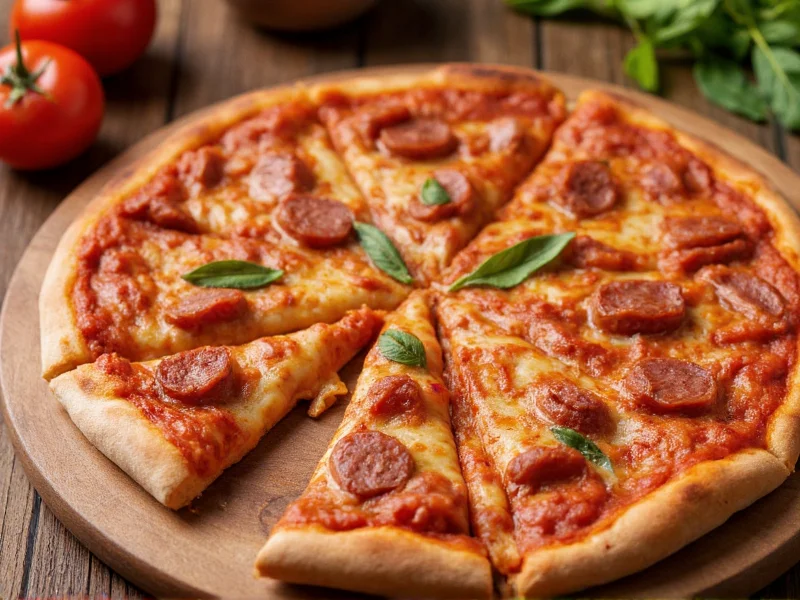When selecting sausage for pizza, understanding meat characteristics and preparation methods makes the difference between a soggy disaster and a perfectly balanced pie. This guide explores sausage varieties, preparation techniques, and flavor pairings backed by culinary science—not just tradition—to help you create exceptional sausage-topped pizzas at home.
Understanding Sausage Composition for Pizza
Sausage isn't just meat in a casing. The ideal pizza sausage maintains a precise 70% lean meat to 30% fat ratio. This balance ensures moisture retention during the high-heat, short-duration pizza baking process (typically 8-12 minutes at 450-500°F). Lower fat content dries out; higher fat content creates greasy pools that prevent proper cheese browning.
Seasoning profiles matter significantly. Traditional Italian sausage contains fennel, garlic, and black pepper—flavors that harmonize with tomato-based sauces. Hot varieties add red pepper flakes for complexity, not just heat. Avoid sausages with high sugar content, as caramelization can create bitter notes when exposed to intense oven heat.
Top Sausage Varieties for Pizza Applications
| Sausage Type | Fat Content | Prep Method | Best Pizza Pairings |
|---|---|---|---|
| Italian (Mild) | 25-30% | Crumble raw | Margherita, Veggie, Four Cheese |
| Italian (Hot) | 25-30% | Crumble raw | Meat Lovers, Spicy Arrabbiata |
| Pepperoni | 30-35% | Slice thin | Classic NY, Supreme |
| Breakfast Sausage | 20-25% | Pre-cook | Breakfast Pizza, Apple & Sage |
| Chorizo (Spanish) | 25-30% | Pre-cook | Southwest, Potato & Cilantro |
Professional Preparation Techniques
Raw sausage requires proper handling to maximize pizza performance. For Italian sausage, remove casing and crumble into 1/4-inch pieces using a fork—this creates irregular edges that crisp beautifully. Never pre-cook Italian sausage completely; partial cooking (70% done) preserves juices while ensuring food safety. The residual heat during pizza baking finishes the cooking process.
Pepperoni demands different treatment. Slice no thicker than 1/8 inch to prevent curling. For optimal cupping (the desirable 'crispy edges with grease pockets' effect), place slices slightly overlapping on the cheese layer. The fat renders downward while edges crisp upward—a textural contrast essential to premium pepperoni pizza.
Flavor Science: Why Certain Pairings Work
Sausage interacts chemically with other pizza components. The umami compounds in cured meats amplify tomato sauce's natural glutamates, creating flavor synergy. Fennel in Italian sausage contains anethole, which enhances perception of sweetness in roasted vegetables like caramelized onions or bell peppers.
Avoid pairing strong-flavored sausages with delicate ingredients. Spicy sausage overwhelms fresh mozzarella's subtle notes but complements robust provolone or aged Parmesan. When using breakfast sausage, balance its sage notes with sweet elements like caramelized apples or maple-glazed bacon.
Common Mistakes and Solutions
Excess grease remains the top sausage pizza failure. Counter this by: (1) Blotting partially cooked sausage with paper towels, (2) Creating a cheese barrier (apply sauce, then light cheese layer, then sausage, then remaining cheese), and (3) Using high-absorption cheeses like part-skim mozzarella.
Undercooked sausage often results from improper sizing. Meat chunks larger than 1/2 inch won't cook through during standard pizza baking times. Maintain consistent 1/4-inch crumbles for even cooking. For thicker sausages like kielbasa, always pre-cook to 160°F internal temperature before adding to pizza.
Creating Signature Sausage Pizza Combinations
Move beyond basic meat lovers with these chef-developed combinations. The 'Tuscan White' features mild Italian sausage with roasted garlic, spinach, and ricotta on olive oil base. For heat lovers, 'Calabrian Fire' combines hot sausage, nduja spread, roasted peppers, and pickled onions on tomato sauce.
Breakfast pizza works year-round when executed properly. Use pre-cooked maple sausage patties with crumbled texture, topped with fontina cheese, roasted potatoes, and a post-bake fried egg. The key is applying sausage directly to dough before sauce to create a moisture barrier against sogginess.
Storage and Handling Best Practices
Raw sausage should remain refrigerated below 40°F until preparation. Never thaw sausage at room temperature—use refrigerator thawing (24 hours) or cold water submersion (30 minutes). Cooked sausage toppings maintain quality for 3 days refrigerated, but texture degrades noticeably after day two.
For meal prep efficiency, portion and freeze raw sausage crumbles in tablespoon measures. Frozen directly on parchment-lined trays, then transferred to bags, they'll last 3 months. Add frozen crumbles directly to pizza—no thawing needed—as the baking process accommodates the temperature difference.
FAQ
What's the difference between pizza sausage and regular sausage?
Pizza sausage typically has higher fat content (25-30% vs 20-25%) and specific seasoning profiles (fennel, garlic) designed to complement tomato sauce and cheese. It's formulated to cook quickly at high temperatures without drying out or releasing excessive grease during the short pizza baking cycle.
Can I use fresh sausage instead of pre-cooked on pizza?
Yes, fresh sausage works better than pre-cooked for most pizza applications. Raw Italian sausage crumbles create superior texture and flavor distribution when baked directly on pizza. The high heat crisps the exterior while keeping the interior juicy. Pre-cooked sausage often dries out during baking, losing its optimal texture and moisture balance.
How do I prevent sausage from making my pizza greasy?
Create a cheese barrier by applying a thin layer of cheese directly on the sauce before adding sausage. Blot partially cooked sausage with paper towels to remove excess surface fat. Choose sausage with 25-30% fat content—lower fat dries out, higher fat creates grease pools. Maintain proper crumble size (1/4 inch) for even cooking without excess rendering.
What cheese pairs best with sausage on pizza?
Mild Italian sausage pairs perfectly with fresh mozzarella for balanced flavor. Hot sausage works better with sharper cheeses like provolone or aged Parmesan that can stand up to its bold flavors. For breakfast sausage pizzas, fontina or gouda provide the creamy texture that complements sage and maple notes without overwhelming them.











 浙公网安备
33010002000092号
浙公网安备
33010002000092号 浙B2-20120091-4
浙B2-20120091-4